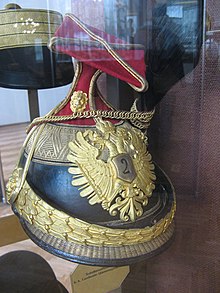Imperial and Royal Uhlans
Army History Museum
, Vienna)Together with the
Austrian Landwehr
, where they were known as the Imperial-Royal Landwehr Uhlans (k.k. Landwehr-Ulanen).
The Austrian monarchy, weakened by losing the
Royal Hungarian Landwehr
(Hungarian: Magyar Királyi Honvédség).
Following the signing of the Compromise, the Austrian half of the Empire also started to build an army, the Imperial-Royal Landwehr (German: k.k. Landwehr). The two new Landwehr forces thus existed alongside the Common Army (Gemeinsame Armee), the imperial army of the whole Empire. In effect this meant that Austria-Hungary had three separate armies at the same time.
Organisation
The Common Army has 11 Uhlan regiments and the Austria Landwehr 6 regiments. By tradition the majority of Uhlans were recruited from the Kingdom of Galicia and Lodomeria. The regiments were also stationed there, with few exceptions.
- In 1914, the Imperial and Royal Cavalry regiments each consisted of 2 divisions (battalions) each of 3 squadrons (Eskadronen).
The Imperial and Royal Uhlans (11 regiments)


- 1st Galician Uhlans (Ritter von Brudermann's) (Galizisches Ulanen-Regiment „Ritter von Brudermann“ Nr. 1)
- 2nd Galician Uhlans (Prince of Schwarzenberg's) (Galizisches Ulanen-Regiment „Fürst zu Schwarzenberg“ Nr. 2)
- 3rd Galician Uhlans (Archduke Carl's) (Galizisches Ulanen-Regiment „Erzherzog Carl“ Nr. 3)
- 4th Galician Uhlans (Emperor's) (Galizisches Ulanen-Regiment „Kaiser“ Nr. 4)
- 5th Ukrainian-Croatian Uhlans (Emperor Nicholas II of Russia's) (Ukrainisch-Croatisches Ulanen-Regiment „Nikolaus II. Kaiser von Rußland“ Nr. 5)
- 6th Galician Uhlans (Emperor Joseph II's) (Galizisches Ulanen-Regiment „Kaiser Joseph II.“ Nr. 6)
- 7th Galician Uhlans (Archduke Franz Ferdinand's) (Galizisches Ulanen-Regiment „Erzherzog Franz Ferdinand“ Nr. 7)
- 8th Galician Uhlans (Count Auersperg's) (Galizisches Ulanen-Regiment „Graf Auersperg“ Nr. 8)
- 11th Bohemian Uhlans (Emperor Alexander II of Russia's) (Böhmisches Ulanen-Regiment „Alexander II. Kaiser von Rußland“ Nr. 11)
- 12th Hungarian (Croatian-Slavonian) Uhlans (Count Huyn's) (Ungarisches (croatisch-slavonisches) Ulanen-Regiment „Graf Huyn“ Nr. 12)
- 13th Galician Uhlans (von Böhm-Ermolli's) (Galizisches Ulanen-Regiment „von Böhm-Ermolli“ Nr. 13)
Imperial-Royal Landwehr Uhlans
- 1st Landwehr Uhlans (Landwehr Ulanen Regiment Nr. 1)
- Assigned as divisional cavalry:
- 1 and 2 Sqns: 11th Infantry Division
- 3 and 4 Sqns: 30th Infantry Division
- 5 and 6 Sqns: 43rd Landwehr Infantry Division
- Nationalities: 65 % Ruthenians - 30 % Polish - 5 % various
- Recruiting district: Lemberg
- Garrison: Lemberg
- 2nd Landwehr Uhlans (Landwehr Ulanen Regiment Nr. 2)
- Assigned as divisional cavalry:
- 1+2 Sqns: 26th Landwehr Infantry Division
- 3+4 Sqns: 29th Infantry Division
- 5+6. Sqns: 10th Infantry Division
- Nationalities: 58 % Czechs - 42 % various
- Recruiting district: Leitmeritz
- Garrison: Hohenmauth
- 3rd Landwehr Uhlans (Landwehr Ulanen Regiment Nr. 3)
- Assigned as divisional cavalry:
- 1+2 Sqns: 45th Landwehr Infantry Division
- 3+4 Sqns: 24th Infantry Division
- 5+6. Sqns: 2nd Infantry Division
- Nationalities: 69 % Poles - 26 % Ruthenians - 5 % various
- Recruiting district: Przemysl
- Garrison: Rzeszów
- 4th Landwehr Uhlans (Landwehr Ulanen Regiment Nr. 4)
- Assigned as divisional cavalry:
- 1+2 Sqns: 5th Infantry Division
- 3+4 Sqns: 12th Infantry Division
- 5+6. Sqns: 46th Landwehr Infantry Division
- Nationalities: 85 % Poles - 15 % various
- Recruiting district: Krakau
- Garrison: Olmütz
- 5th Landwehr Uhlans (Landwehr Ulanen Regiment Nr. 5)
- Assigned as divisional cavalry:
- 1+2 Sqns: 4th Infantry Division
- 3+4 Sqns: 25th Infantry Division
- 5+6. Sqns: 13th Landwehr Infantry Division
- Nationalities: 97 % Germans - 3 % various
- Recruiting district: Vienna
- Garrison: Stockerau
- 6th Landwehr Uhlans (Landwehr Ulanen Regiment Nr. 6)
- Assigned as divisional cavalry:
- 1+2 Sqns: 3rd Infantry Division
- 3+4 Sqns: 8th Infantry Division
- 5+6. Sqns: 44th Landwehr Infantry Division
- Nationalities: 60 % Germans - 39 % Czechs - 1 % various
- Recruiting district: Prague
- Garrison: Wels
Sources
- Austrian State Archives/War Archives in Vienna
- Glenn Jewison, Jörg C. Steiner: The Austro-Hungarian Land Forces 1848-1918
Literature
- Johann C. Allmayer-Beck, Erich Lessing: Die K.u.k. Armee. 1848-1918. Verlag Bertelsmann, München 1974, ISBN 3-570-07287-8.
- Das k.u.k. Heer im Jahre 1895 Schriften des Heeresgeschichtlichen Museums in Wien - Stocker Verlag, Graz 1997
- k.u.k. Kriegsministerium„Dislokation und Einteilung des k.u.k Heeres, der k.u.k. Kriegsmarine, der k.k. Landwehr und der k.u. Landwehr“ in: Seidels kleines Armeeschema - Herausg.: Seidel & Sohn Wien 1914
- „Adjustierungsvorschrift für das k.u.k. Heer, die k.k. Landwehr, die k.u. Landwehr, die verbundenen Einrichtungen und das Korps der Militärbeamten“ von 1867 Herausgegeben durch das k.u.k. Kriegsministerium Wien. Fassung von 1911/1912



